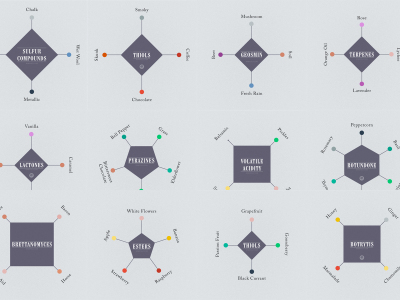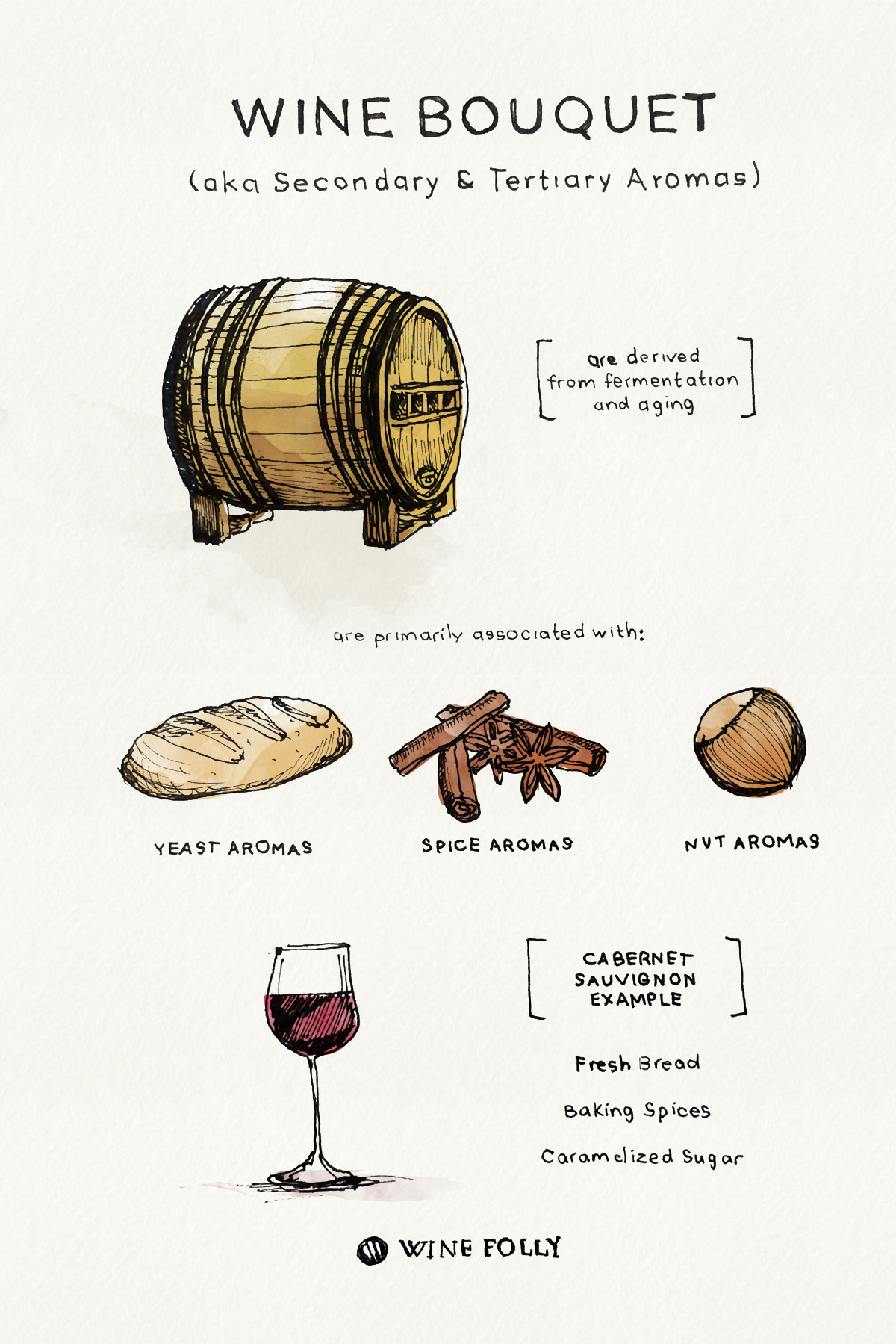The terms wine aroma and wine bouquet are not exactly scientific but they can be useful to classify the origin of where the smells come from in wine. Very simply, a wine aroma is derived from the grape variety (e.g. Zinfandel or Cabernet Franc) and a wine bouquet is derived from the winemaking process of fermentation and aging. A classic example of a wine bouquet is the smell of vanilla, which usually comes from aging wine in new oak barrels.
Let’s explore the 2 types of wine smells (aromas and bouquets) and provide a few examples to distinguish which is which.
Wine Aromas
(aka Primary Aromas)
From Variety (aka Primary Aromas): When made into wine, each grape variety offers a unique set of aromas called primary aromas. These aromas are typically in the realm of fruit smells, herb smells and flower smells and come naturally just from the grape. For example, Cabernet Sauvignon is commonly noted for its smells of raspberry, green peppercorn and, sometimes, violet. The smells come from aroma compounds which are found in different levels in different varietal wines. It is true that on a molecular level, these aroma compounds look identical to actual fruit smells. So, for example, the compound that produces the smell of strawberries in strawberry jam looks the same as the compound that produces the smell of strawberry jam in a glass of California Barbera.
Aromas commonly associated with varieties:
- Fruit flavors (e.g. peach, blackberry)
- Herbal flavors (e.g. bell pepper, mint, oregano)
- Flower flavors (e.g. roses, lavender, iris)
Wine Bouquets
(aka Secondary and Tertiary Aromas)
From Fermentation (aka Secondary Aromas): Fermenting wine essentially turns grape sugars into alcohol and is commonly associated with a specific yeast called Saccharomyces cerevisiae (essential in winemaking, baking and beer brewing for thousands of years). The process of fermentation creates a group of bouquets that are commonly referred to as Secondary Aromas. You’re no doubt already familiar with secondary aromas, for example: freshly baked sourdough bread.
Bouquets commonly associated with fermentation:
- Cultured Cream (yoghurt)
- Buttermilk
- Butter (commonly from a bacterial process called Malolactic Fermentation)
- Beer (commonly found in wines aged on the lees)
- Brewer’s Yeast
- Aged Cheese (Parmesan)
- Sourdough
- Mushroom
- Grandmother’s Cellar
- Horse Sweat (from Brettanomyces)
- Band-Aid (from Brett)
- Wild Game (from Brett)
- Duck Crackling / Bacon (from Brett)
From Aging (aka Tertiary Aromas): Aging wine introduces elements that add (or alter) the aroma compounds in wine after it’s fermented. The group of bouquets associated with aging are called Tertiary Aromas. The most important element of aging is exposing wine to oxygen. In small amounts, oxygen produces positive smelling bouquets including the aromas of hazelnut and roasted peanut. The next most common element is the use of oak. Oak barrels do double-duty on a wine by slowly introducing oxygen (nuttiness) as well as adding aroma compounds found in oak (in the same way tea leaves flavor hot water). A final element of aging to mention (much less commonly used) is the practice of purposely heating or cooking a wine. Cooking a wine causes Maillard reaction where sugars and amino acids react with one another, turn brown, and caramelize. You are already familiar with reaction flavors if you’ve ever toasted a marshmallow, yearned for a seared steak, or have tasted French onion soup. In wine, reaction flavors are commonly referred to as Madeirizing, in reference to the most famous wine produced with this technique: Madeira.
Bouquets commonly associated with aging:
- Brown Sugar
- Vanilla
- Caramel
- Butterscotch
- Hazelnut
- Walnut
- Roasted Almond (different than fresh almond or bitter almond)
- Toasted Marshmallow
- Clove, Allspice, Baking Spices
- Cedar Box
- Cigar box
- Smoke
- Dried Tobacco
- Dried Leaves


Where Wine Aromas Come From
Why do wines smell like so much more than just grapes? Understand what aroma compounds are behind the hundreds of aromas found in wine.
The Science of Wine Aromas

